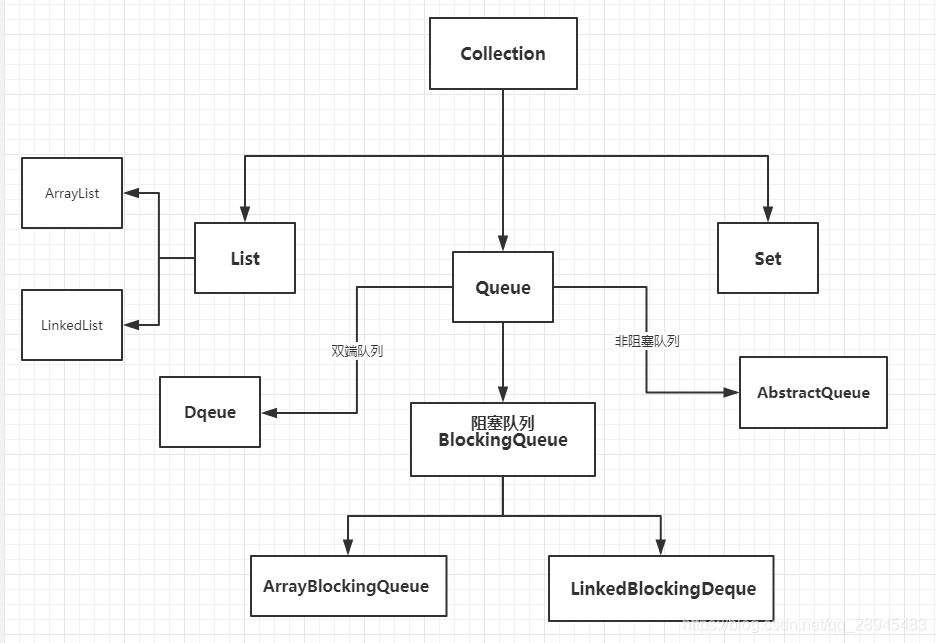JUC中 阻塞队列和线程池
2020-03-28 20:16
441 查看
一、阻塞队列(blockQueue)
队列满的时候再放入和空了再取一定会发生阻塞!
父级是queue,和list,set等同级并继承父类collection。另dueue是双端队列,效率高,其中同步队列SynchronousQueue一次只有一个元素。不会造成阻塞
 队列的存入和取值策略:
队列的存入和取值策略:
| 方法 | 第一组会抛出异常 | 返回一个布尔值,不会抛出异常 | 延时等待 | 一直等待 |
|---|---|---|---|---|
| 插入 | add() | offer(e) | offer(e,time) | put() |
| 取出 | remove() | poll() | poll(time) | take() |
| 检查 | element() | peek() | - | - |
二、线程池
提高程序性能,充分利用计算机的资源。
了解线程池的3+7+4
1、3大方法(阿里不允许使用,会出OOM异常,最大是integer.MAX_VALUE,2的31次方,CPU冒烟)
import java.util.concurrent.ExecutorService;
import java.util.concurrent.Executors;
public class ThreadPoolDemo01 {
public static void main(String[] args) {
// 单例,只能有一个线程!
// ExecutorService threadPool = Executors.newSingleThreadExecutor();
// 固定的线程数
// ExecutorService threadPool = Executors.newFixedThreadPool(8);
// 遇强则强!可伸缩!
// ExecutorService threadPool = Executors.newCachedThreadPool();
try {
// 线程池的使用方式!
for (int i = 0; i < 30; i++) {
threadPool.execute(()->{
System.out.println(Thread.currentThread().getName() + " ok");
});
}
} catch (Exception e) {
e.printStackTrace();
} finally {
// 使用完毕后需要关闭!
threadPool.shutdown();
}
}
}
2、7大参数
public ThreadPoolExecutor(int corePoolSize, // 核心池线程数大小 (常用)
int maximumPoolSize, // 最大的线程数大小 (常用)
long keepAliveTime, // 超时等待时间 (常用)
TimeUnit unit, // 时间单位 (常用)
BlockingQueue<Runnable> workQueue, // 阻塞队列(常用)
ThreadFactory threadFactory, // 线程工厂
RejectedExecutionHandler handler // 拒绝策略(常用)) {
if (corePoolSize < 0 ||
maximumPoolSize <= 0 ||
maximumPoolSize < corePoolSize ||
keepAliveTime < 0)
throw new IllegalArgumentException();
if (workQueue == null || threadFactory == null || handler == null)
throw new NullPointerException();
this.acc = System.getSecurityManager() == null ?
null :
AccessController.getContext();
this.corePoolSize = corePoolSize;
this.maximumPoolSize = maximumPoolSize;
this.workQueue = workQueue;
this.keepAliveTime = unit.toNanos(keepAliveTime);
this.threadFactory = threadFactory;
this.handler = handler;
}
3、4大拒绝策略
* 1、ThreadPoolExecutor.AbortPolicy(); 抛出异常,丢弃任务 * 2、ThreadPoolExecutor.DiscardPolicy();不抛出异常,丢弃任务 * 3、ThreadPoolExecutor.DiscardOldestPolicy(); 丢弃前尝试获取任务,不一定执行! * 4、ThreadPoolExecutor.CallerRunsPolicy(); 哪来的去哪里找对应的线程执行!
4、最大线程池的设置
CPU密集型: 根据CPU的处理器数量来定!保证最大效率,获得服务器cpu核数:Runtime.getRuntime().availableProcessors(); IO密集型: 50 个线程都是进程操作大io资源, 比较耗时! > 这个常用的 IO 任务数!
- 点赞
- 收藏
- 分享
- 文章举报
 qq_28945483
发布了6 篇原创文章 · 获赞 0 · 访问量 67
私信
关注
qq_28945483
发布了6 篇原创文章 · 获赞 0 · 访问量 67
私信
关注
相关文章推荐
- 【高并发10】JUC组件扩展(FutureTask, Fork / Join 并行框架 ,阻塞队列BlockingQueue)
- 阻塞队列应用之线程池
- 线程池的阻塞队列以及饱和策略处理
- spring线程池ThreadPoolTaskExecutor与阻塞队列BlockingQueue
- 阻塞队列模型和线程池
- 利用队列的自动阻塞和线程池来做线程的生产消费
- 线程池的启动方式,以及线程池中的阻塞队列
- 生产者消费者模式--阻塞队列--LOCK,Condition--线程池
- 线程池和阻塞队列的组合使用
- Java-五种线程池,四种拒绝策略,三种阻塞队列
- java高并发系列 - 第25天:掌握JUC中的阻塞队列
- Callable,阻塞队列,线程池问题
- 线程池 阻塞队列
- 线程池中为什么要使用阻塞队列?
- 跟我学Java多线程——线程池与阻塞队列
- 跟我学Java多线程——线程池与阻塞队列
- 线程池ThreadPoolExecutor与阻塞队列BlockingQueue
- JUC学习笔记三:AQS并发工具类;读写锁;阻塞队列
- Java并发编程:阻塞队列(Blocking Queues)、线程池(Thread Pools)的原理与代码实现
- 线程池和阻塞队列
